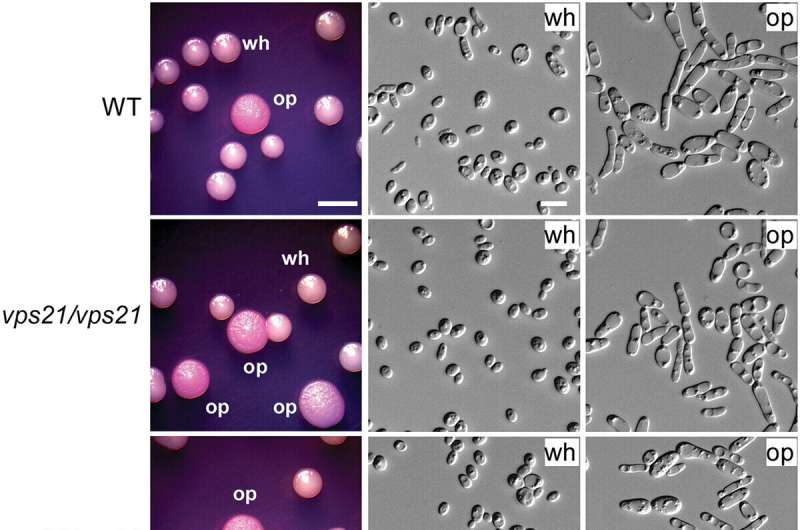
Function of Vps21 and its variants in the regulation of white-to-opaque switching. Credit: Mycology (2024). DOI: 10.1080/21501203.2024.2376533
In a paper published in Mycology, a team of scientists present that the conserved Vps21 signaling pathway plays critical roles in the regulation of white-opaque switching and mating in the major human fungal pathogen C. albicans.
This study was led by Dr. Guanghua Huang (School of Life Sciences, Fudan University). The team discovered that the conserved Vps21 signaling pathway plays critical roles in the regulation of white-opaque switching and mating in Candida albicans, a major human fungal pathogen.
Candida albicans is able to cause cutaneous diseases as well as life-threatening systemic infections in humans. It has multiple cellular morphologies and can undergo transitions among different morphologies to adapt to environmental changes.
White-opaque transitions represent a typical morphological phenotypic switching system in this fungus. White and opaque cells differ in a number of aspects, such as virulence and cellular morphologies. Opaque cells often contain large vacuoles.
Since the Vps21 signaling pathway is associated with vacuolar trafficking and protein sorting in fungi, the researchers set out to investigate whether this pathway is involved in the regulation of white-opaque switching and sexual mating in C. albicans.
The major components of the Vps21 signaling pathway include the Vps21 GTPase, Vps9 (a guanine nucleotide exchange factor for Vps21), and downstream factors (Vps3, Vac1, and Pep12). The authors found that inactivation of the major components of the Vps21 signaling pathway promoted white-to-opaque switching but suppressed mating in C. albicans.
Quantitative RT-PCR assays demonstrate that the relative expression levels of mating related genes (MFα, STE3, FUS1, FIG1, and CPH1) and genes of the mating-specific MAPK pathway (CST20, STE11, HST7, CEK1, and CEK2) were significantly downregulated in the vps21/vps21, vps9/vps9, vps3/vps3, vac1/vac1, and pep12/pep12 mutant strains (compared to the WT control strain). This downregulated expression of the mating-associated genes could directly affect the mating efficiencies of the mutant strains.
This study sheds new light on the biological role of the Vps21 signaling pathway in the regulation of morphological transitions and sexual mating in C. albicans.
More information:
Fei Zhao et al, The Vps21 signalling pathway regulates white-opaque switching and mating in Candida albicans, Mycology (2024). DOI: 10.1080/21501203.2024.2376533
Provided by
Tsinghua University Press
Citation:
Study: Vps21 signaling pathway regulates white-opaque switching and mating in Candida albicans (2024, July 17)
retrieved 18 July 2024
from https://phys.org/news/2024-07-vps21-pathway-white-opaque-candida.html
This document is subject to copyright. Apart from any fair dealing for the purpose of private study or research, no
part may be reproduced without the written permission. The content is provided for information purposes only.
>>> Read full article>>>
Copyright for syndicated content belongs to the linked Source : Phys.org – https://phys.org/news/2024-07-vps21-pathway-white-opaque-candida.html










